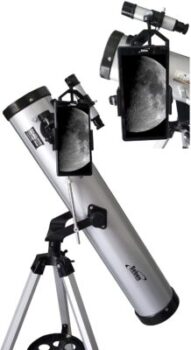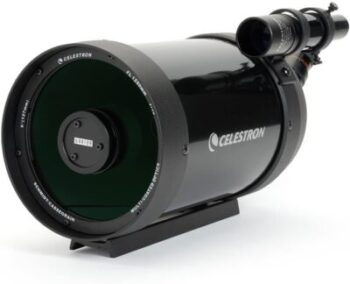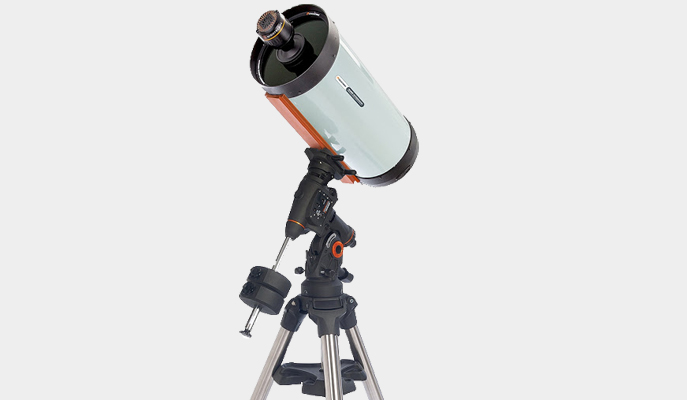in the UK, astronomical events are customary. Every year, thousands of enthusiasts gather at astronomical observation sites. You too can observe the stars in the open air or at home with a telescope. And if you're looking for the best value, we recommend the Slokey SkyWays 50080. To learn more, read this comparison guide.
Here is our commitment, to make sure that we provide the best user experience and content quality:
You can support us by using our links to make your purchases (at no extra cost to you)! This sometimes earns us a commission which allows us to remain independent. More about us
Our selection
"The Slokey SkyWays 50080 is our first choice. Firstly because it offers the best value for money. But it is also an ultra versatile telescope,…"
"This 700 mm reflecting telescope surprises by its price positioning, allowing a first foray into the field of astronomy. It is perfect for beginners, without…"
"Robust, the Omegon 150/750 EQ-3 promises great separating power, thanks to the 150 mm aperture. With its robust design, it also has the necessary features…"
"The Celestron C5 telescope is a best-seller. It works so well that NASA chose it for several space missions in the 1990s! Even today, this…"

The Slokey SkyWays 50080 is our first choice. Firstly because it offers the best value for money. But it is also an ultra versatile telescope, suitable for beginners and enthusiasts alike.
See priceThe Slokey SkyWays 50080 has an 80mm aperture and a focal length of 500mm. In theory, the SkyWays 50080 gains 25% more precision and sharpness than the SkyWays 50070. You also get an additional 6mm eyepiece, not to mention the 25mm and 10mm eyepieces. In addition, you have 6 magnification options on this telescope, ranging from 20x to 250x, but you'll get the best compromise between power and image quality between 120x and 150x. Chromatic aberration reduction is omnipresent, good to know if you are a beginner.

This 700 mm reflecting telescope surprises by its price positioning, allowing a first foray into the field of astronomy. It is perfect for beginners, without neglecting the power.
See the priceSeben's signature 700mm reflecting telescope takes you on a journey through distant stars and galaxies, with the ability to record your observations on a smartphone. This Seben telescope is able to offer top-notch performance thanks to the use of high-quality components, including 4 H20, H12.5, H6 and SR4 eyepieces, a rectifying lens, a lunar filter, a Barlow lens and a scopefinder. The camera itself benefits from an azimuth type mount for mounting a digital camera and a very solid aluminum tripod.

Robust, the Omegon 150/750 EQ-3 promises great separating power, thanks to the 150 mm aperture. With its robust design, it also has the necessary features for advanced observations.
See priceThe Omegon 150/750 sends out the heavy stuff with a fast aperture ratio of 1:5. In concrete terms, this allows a high light gathering power, ensuring a very high level of detail for the observed objects. The light gathering capacity of the human eye is here multiplied by 600! Galaxies, nebulae, stars, satellites, you will see it all. With this telescope, the planets will reveal some of their secrets. For example, you can observe and follow the cloud bands of Jupiter that carry the great red spot on the planet. The shadows cast by Jupiter's largest moons will also be visible with a 150mm aperture.

The Celestron C5 telescope is a best-seller. It works so well that NASA chose it for several space missions in the 1990s! Even today, this hybrid telescope remains a safe bet.
See the priceThe Celestron C5 embeds a Schmidt-Cassegrain optic of 127 mm, a must for both animal observation and astronomy. It benefits from a 25 mm eyepiece with a 50x magnification. This hybrid telescope is so efficient that NASA has used it during some space missions. Weighing 2.72 kg and measuring 33 cm long, it offers a portable visual and photographic instrument suitable for all conditions. Plus, you can expand its capabilities with a number of optional accessories, including a wide range of 1.25-inch mount eyepieces.
Any specific needs?
The best entry-level telescope
The best hybrid long-view telescope
Your guide :
Rate this buying guide :By rating this buying guide, you are helping us to reward our best writers. Thank you!
| TOP OF THE TOP | CHEAP | TOP OF THE LINE | EXCELLENT | |

In accordance with our commitment, this buying guide does not contain any sponsored products. |
 9/10 |
 8/10 |
 9/10 |
 8/10 |
| OUR SELECTION |
Slokey SkyWays 50080
|
Seben 700-76
|
Omegon 150/750 EQ-3
|
Celestron C5
|
|
The Slokey SkyWays 50080 is our first choice. Firstly because it offers the best value for money. But it is also an ultra versatile telescope, suitable for beginners and enthusiasts alike.
|
This 700 mm reflecting telescope surprises by its price positioning, allowing a first foray into the field of astronomy. It is perfect for beginners, without neglecting the power.
|
Robust, the Omegon 150/750 EQ-3 promises great separating power, thanks to the 150 mm aperture. With its robust design, it also has the necessary features for advanced observations.
|
The Celestron C5 telescope is a best-seller. It works so well that NASA chose it for several space missions in the 1990s! Even today, this hybrid telescope remains a safe bet.
|
|
|
|
Suitable for beginners and seasoned observers
|
DKA5 smartphone adapter
|
150 mm aperture
|
Can be used to observe the stars but also nature
|
|
|
Barlow 3x lens
|
High quality components
|
31.75 mm eyepiece holder
|
Reliable: even NASA has used it!"
|
|
|
Phone adapter
|
Remarkable performance for the price
|
Primary and secondary optics adjustment screws
|
High performance 1250mm f/10 telephoto lens for digital camera
|
Help us improve this table:
Report an error, request the addition of a feature to the table, or suggest another product. Thank you for your kindness!
We spend thousands of hours each year studying the major specialized websites, analyzing products of hundreds of brands and reading user feedback to advise you on the best products.
We are a product review company with a single mission: to simplify your buying decisions. Our research and testing helps millions of people every year find the best products for their personal needs and budget.
To support us you can: use our links to make your purchases (which often earns us a small commission), share our articles on social networks, or recommend our site on your blog. Thanks in advance for your support!
The technical characteristics concern particularly the power of the telescope and the eyepiece for the magnification. The power will depend on its diameter or its aperture. The larger the diameter, the more detailed the images are. For the eyepiece, the smaller it is, the brighter the image. The 31.75 mm model, or 1.25 inches, is the most commonly used.
A model equipped with 60 to 80 mm aperture lenses is sufficient to observe the Moon. This type of lens is found on refracting telescopes. But if you want to get more detailed images, a version with a mirror optical system larger than 100 mm is a good option. Only refracting telescopes have this type of lens.
For terrestrial observation, the telescope is ideal. In addition to astronomical observation, it allows you to observe nature, birds, landscapes as far as the eye can see. However, you will not be able to admire the depths of the sky with this type of device. A reflecting telescope will be necessary for you to observe the objects of the sky. Classified in the category of mirror telescopes, the reflecting telescope allows you to observe the sky at your leisure. Some brands are adapted to astrophotography.
The
telescope is fixed on an azimuthal or equatorial mount, itself installed on a tripod. The tripod ensures the stability of the telescope. The azimuth mount is easy to use and this type of mount is perfect for quick observation of the sky. It is also suitable for terrestrial observations. The equatorial mount, on the other hand, allows astronomical observation with more precision. It will be possible to follow the movement of stars, location of objects in the sky, etc..
For a beginner or a child: an astronomical telescope can be a wise choice, especially for a discovery of astronomy. Its use requires few adjustments.
On the other hand, long-time astronomy enthusiasts will prefer a 114 mm telescope, as it also allows taking pictures. For a more detailed observation of the sky, it would be preferable to choose a model equipped with a much larger eyepiece diameter, at 150 mm or more.
Good maintenance guarantees the durability of your telescope. When it is not in use, it is recommended to preserve it from dust and moisture. The first thing to do is to protect the lenses. The slightest friction can scratch the lenses of your telescope. When the telescope is not in use, it is recommended to use a lens cover.
Until you have one, use a temporary object with a rubber band around the edges. Lenses should also be protected. Store them in a well-sealed bag or, better yet, in their case. Lash contact on the lens leaves a mark. If this becomes a recurring problem, look for a higher-clearance lens that prevents your eye from sticking to the camera.
Improper storage can also be detrimental to your telescope. You should always put your telescope away after each use. It will have its own container that is preferably padded. Choose a waterproof case for added precaution. Once the telescope is disassembled, each part must be put away in its proper place. The tripod should be stored separately in a special bag.
A special carrying case can solve storage problems. In any case, the best solution is to buy a transport material recommended by the manufacturer.
Telescopes are divided into 2 large families: the astronomical glasses and the catadioptric telescopes. As we will see, each one has its advantages and disadvantages.

The telescope is mainly used for planetary observation. Its objective is made of a set of lenses. In addition to observing the sky, this instrument allows you to observe nature and birds. This type of telescope has the advantage of being affordable and requires very little maintenance. It is therefore recommended for beginners.
On the other hand, if you want to observe the depths of the sky, you will have to pass your way. Finally, it should be noted that this type of telescope can suffer from color distortion, resulting in blurred images.

This
type of telescope is ideal for observing stars and planets, and for engaging in astrophotography. It uses both a refractive lens and a reflecting mirror. This type of telescope has the advantage of being robust and compact. You will have no difficulty in transporting it, nor in installing it.
However, catadioptric telescopes are more expensive and can suffer from light loss. Perfectly versatile, the catadioptric telescope is the ideal instrument to observe both nature and the sky.
The Newton type reflecting telescope is composed of mirrors. It is the most common model on the market. Its simplicity of design has a direct influence on its affordable price. Its principle of operation is based on the properties of reflection of the 2 mirrors which constitute it.
However, it is necessary to align the mirrors to obtain a perfect optical performance. In addition, the handling and adjustments necessary for the proper functioning of this type of equipment require a good technical approach from the user. As such, the reflecting telescope is best suited to experienced astrophotographers.
The telescope has been around for over 400 years. This observation instrument belongs to the category of refracting telescopes. It works like a telescope and uses the principle of refraction of light, which travels in a straight line through the front lens to the observer's eye. Its contrast and sharpness levels are particularly appreciated in astrophotography. In addition, it requires little maintenance and remains accessible to children.
A common problem for urban observers and amateur astrophotographers is light pollution caused by nearby artificial lighting. Less sensitive to light pollution, the refractor telescope provides a solution to this problem. The user can thus easily locate objects, both in astronomical and terrestrial use.
If you are used to handling a telescope, the reflecting telescope is ideal for your observations, because of its stability and comfort. For a less complicated handling and intended for the children or the beginners, better opt for the refractor telescope or with lens for more precautions.

Long distance observation
A telescope allows you to observe very distant objects invisible to the naked eye. Thanks to its reflective effect, it allows you to see the depth of the sky, to observe stars, planets and comets. Its optical magnification also increases the size of objects.
Observation of the deep sky
Telescopes are capable of capturing countless celestial objects. If you want to observe the deep sky, nebulae and galaxies, you can opt for a model with a short focal length. This way, you will get better results, as this model is intended for observing faint objects. Moreover, having a professional telescope also allows you to feed your passion for astronomy and to get closer to what makes you dream.
Observation of planets and stars
Who doesn't dream of seeing everything in the sky and beyond up close? If you don't have a space shuttle, you can observe the planets and stars with a long-focus telescope. This feature allows the device to offer you a significant magnification. Indeed, when the telescope has a large focal ratio, it is better suited to observe bright objects. In addition to being entertaining, it is a device accessible to all. You can buy one for a few hundred euros.
Image quality
Chromatic aberration is the result of white light being broken down into several colour bands. If you want to have an image with great precision, the telescope can satisfy you. Indeed, it works without chromatic aberration. Thus, the image will be clear and the contours will not be iridescent.
Guidance system
Some telescope models are equipped with a GoTo system. This allows you to point at a celestial object and follow it automatically. So you don't need any knowledge of the sky.
In our opinion, the best brands of telescopes in 2022 are :
Based in California, USA, Celestron manufactures and markets binoculars and telescopes and other optical instruments of high repute. Designed for a wide audience, its products are generally of excellent quality.
For almost 60 years, the German company Bresser has been active in the market of binoculars and telescopes. The company's ambition is to satisfy the needs of its many customers, both beginners and enthusiasts. We emphasize the quality of its products, combined with a careful design.
Founded in 1948, Bushnell Corporation is an American company specializing in optical instruments, including binoculars, telescopes and other observation glasses. We appreciate the excellent quality/price ratio of its products.
Slokey is a manufacturer of high performance, reliable and often cost effective optical equipment and instruments. The brand has thousands of satisfied customers, especially with its telescopes.
Founded in 1979 in Northern Italy, Konus is specialized in the field of optical instruments and in particular telescopes, scopes and binoculars. We appreciate the user-friendliness of its product range and its competitive prices.
The diagram below will help you to get an idea of the typical prices for each price range (entry-level, mid-range and high-end).
However, more expensive does not necessarily mean better.
We therefore advise you to always consult our ranking before deciding, rather than blindly relying on price ranges.
Plan your observation session
Sky maps will help you find your way in the night sky. Downloadable cell phone applications and various dedicated computer programs will guide you in your exploration.
Keep both eyes open
When
observing an object through the eyepiece of your telescope, it is best to keep both eyes open. By closing one eye, you risk tiring your muscles. Over time, this prolonged effort can distort your vision and decrease your visual acuity.
Give yourself time to get used to the dark
Your
eyes need time to adapt to the dark. Allow at least 30 to 45 minutes to adjust.
Join an astronomers' club
Participating
in the activities of astronomical observation centers can help you in your choice. You will have the opportunity to familiarize yourself with the basics of how telescopes work, before moving on to purchase.
Leave your cell phone inside or turned off
The
light from your phone, in addition to being a source of light pollution, can make it difficult for your eyes to adjust to the dark. Unless you are using an app that is necessary for your viewing experience, turn your device off.
The best telescope depends on your needs and your budget. Read our buying guide to find the best products out there.
The telescope is a good option if you want to observe the stars, the moon and the beauties of nature. Its use is limited, however, as it does not allow you to observe the deep sky.
It is preferable to use a telescope or catadioptric telescope, rather than a single mirror telescope.
Catadioptric or mirror telescopes are best. Since they collect light well, they will give good results.
Its main advantage is its versatility. It can be used for deep sky observation, astrophotography, bird watching and landscape observation...
Every month we help more than 1 000 000 people buy better and smarter.
Copyright © 2022 - Made with ♥ by buyingbetter.co.uk
Your reviews and buying guides 0% advertising, 100% independent!